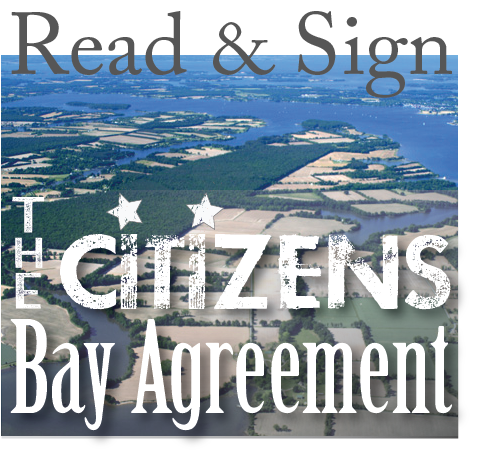Chesapeake Bay Action Plan
After decades of effort, the voluntary, collaborative approach to restoring the health and vitality of the Chesapeake Bay— the largest estuary in the United States—has not worked and, in fact, is failing.
A diverse group of 57 senior scientists and policymakers have joined forces to save the Bay. This is our plan.
Industrial Agriculture Is Killing the Bay
(Posted by Tommy Landers.)
Agriculture is not a monolith. It’s important to make a distinction between farmers who work the land and agribusiness interests who work the political system.
Big Poultry Needs to Clean Up After Itself
(Posted by Scott Edwards.)
As of 2008, despite the trumpeting of significant progress made in agricultural discharges of nutrients into the Bay, the industry was still pumping 100 million pounds of nitrogen and over 8 million pounds of phosphorus per year into the Chesapeake Bay watershed.
Chesapeake Bay: An Open Toilet
(Posted by Scott Edwards.)
The old grey mare just ain’t what she used to be. And for that matter, neither are those chickens. Or the cows. And you just wouldn’t recognize the pigs. Even if you could see them. But you can’t. Because they spend their entire, short life in darkened, crowded, filthy sheds. Nope, farms just aren’t what they used to be. In fact, they aren’t really even farms anymore. They’re factories. Every bit as much a factory as a papermill. Or a chemical processing plant. Put away your pastoral picture book – there’s nothing quaint or country about them.
Making Conservation Pay
(Posted by Bob Parks)
Many on the Western Shore of Maryland assume that the Eastern Shore is all chicken houses, but of course that’s not the case. The Upper Eastern Shore is, in fact, primarily grain farming. The Clean Water Act, however, does not regulate grain farming. Simply put, grain farming is the ultimate nonpoint source of nitrogen and phosphorus. You cannot identify (or regulate) the farmer whose field is sending nitrogen into the ground water that ends up in the rivers and the Bay.
Agriculture & the Decline of Smallmouth Bass
(Posted by Robert A. Bachman.)
In a resolution passed unanimously at its winter quarterly meeting on January 10, 2010, the Pennsylvania Fish and Boat Commission made the following declaration:
…The Board of Commissioners of the Pennsylvania Fish & Boat Commission hereby expresses deep concern for the health of the Susquehanna River’s smallmouth bass fishery and asserts there is evidence showing that the water quality of the Susquehanna River has become increasingly impaired to the level that it is seriously impacting important elements of the Susquehanna River fishery, especially its nationally-reputed smallmouth bass fishery.”
Video: Are Farmers the Bad Guys?
When it comes to who’s responsible for polluting the Chesapeake Bay, farmers can feel singled out. Gerald Winegrad sets the record straight.
Agriculture: No. 1 Bay Polluter
(Posted by Gerald Winegrad.)
After 27 years of formal recovery efforts under the Bay Program, the Chesapeake Bay remains severely degraded and bay recovery is failing. About 90 percent of Bay waters remain impaired in clear violation of the Clean Water Act with collapsed fisheries, including oysters and shad. We have so poisoned our waters that reports abound of serious infections in humans who come in contact with Bay waters. Catfish in the South River have cancerous lesions and male bass from the Potomac are turning up with female egg sacs.
Agriculture and the Bay: What the Science Shows
(Posted by Ed Hatcher.)
Dear Bay Action Plan Readers,
Welcome to Day 1 of the Bay Action Plan’s month-long focus on Agriculture and the Bay: What the Science Shows.
Former Maryland state Senator Gerald Winegrad discusses how agriculture contributes to bay pollution:
See all our videos here.
Click to view a one-hour webinar on “Reaching Our Nutrient Reduction Allocations,” conducted by Dr. Russell B Brinsfield, and Dr. Ken Staver, both of the University of Maryland Wye Research and Education Center. (Webinar will open in a new window.)
We are senior Chesapeake Bay scientists and policymakers from Maryland, Virginia and Pennsylvania who have concluded that after decades of effort, the voluntary, collaborative approach to restoring the health and vitality of the largest estuary in the United States has not worked and, in fact, is failing. Our group unanimously recommends that all states draining into the Chesapeake Bay adopt our 25 action items in their Watershed Implementation Plans (WIP) and implement them to improve the Bay’s water quality and to meet the requirements of the Clean Water Act.
Sign up for news & updates from Patuxent Riverkeeper

